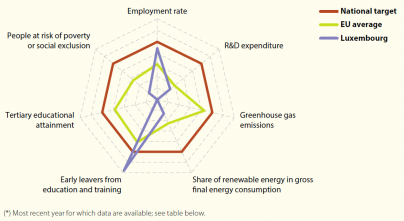Archive:Europe 2020 indicators - Luxembourg
- Data from December 2014. Most recent data: Further Eurostat information, Main tables.
This article is part of a set of statistical articles based on the Eurostat publication Smarter, greener, more inclusive? - Indicators to support the Europe 2020 strategy. It provides recent statistics on the Europe 2020 strategy of the European Union (EU), focusing on the situation in Luxembourg.

Main statistical findings

Luxembourg has the most ambitious target on tertiary education across the EU, envisioning 66 % of the population aged 30 to 34 to have attained tertiary education by 2020. Despite an almost continuous rise between 2009 and 2013 to 52.5 %, putting Luxembourg in second place across the EU, the country was still the farthest from its national target. In contrast, the country has been exceeding its target on early leavers from education and training since 2009, and in 2013 was closer to its employment target than the EU average. In 2013, the country was bellow the EU average in terms of R & D expenditure and the gap to the national target has widened since 2009. The number of people at risk of poverty or social exclusion rose by one-third between 2008 and 2013, pushing Luxembourg farther from its poverty alleviation target. In relation to its climate change and energy targets, it has remained far behind the EU average in the uptake of renewable energies. In 2012 it also faced the largest gap to its GHG emissions target across the EU.
Data sources and availability
More information about the origin of the data and the calculation of indicators can be obtained via the Europe 2020 indicators dedicated website.
Under 'Tables', click on the icons next to the indicators:
- 'Explanatory texts (metadata)' for a detailed overview of the collection and compilation methods;
- 'Information on the leaf' for data availability per country.
A more general overview of quality procedures can be found in Implementation of standard reference metadata for indicators - the ESMS Indicator Profile (ESMS-IP) (PDF file).
See also
Further Eurostat information
Publications
- Smarter, greener, more inclusive - indicators to support the Europe 2020 strategy (online publication, also downloadable as PDF file)
Main tables
Dedicated section
Methodology / Metadata
- Towards robust quality management for European Statistics - Communication from the Commission to the European Parliament and the Council COM(2011) 211 final.
Other information
- Regulation 223/2009 of 11 March 2009 on European statistics